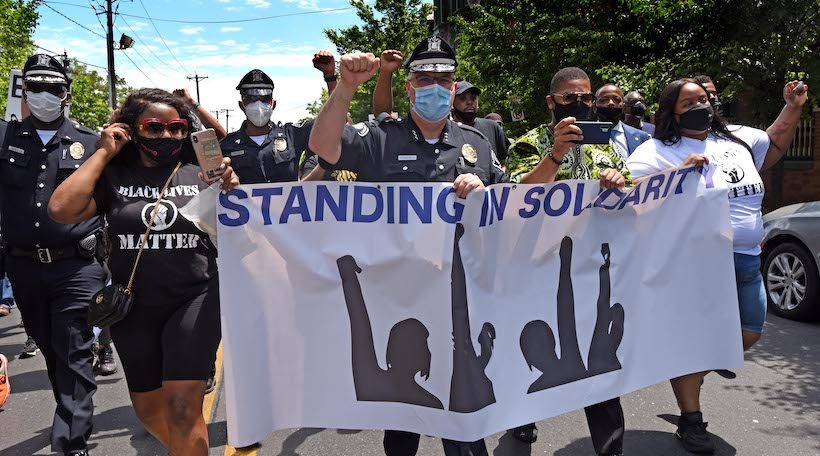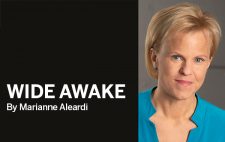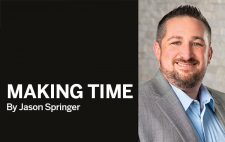Photo: April Saul
For Camden Police Chief Joe Wysocki, you could say he was destined to have the job he has, and in the city he has it in. It kind of runs in the family.
His dad (also named Joe) was hired by the Camden police department in 1974 and served for 30 years. His father-in-law was hired that same year and served for 26.
Wysocki joined the department in 1991 and was a detective when he met his wife, who was working as one of the department’s dispatchers. All this to say: the Chief’s history of policing Camden is a long one, but its most memorable chapter is the here and now.
Not even a year into his new position, Chief Wysocki and his department received national recognition last month as protests erupted throughout the country after the murder of George Floyd in Minneapolis. While the country watched as many of those protests turned violent, Wysocki made the decision to march alongside the protestors gathering in Camden.
“Being a part of the community means being there,” the soft-spoken chief says. “I know temperatures were high in the country, and emotions were very high in Camden, too. When we went out that day it was a conscious decision for no officers to have riot gear or combat gear. Before we marched, everyone got into a circle and prayed: for peace, for the city, for George Floyd. We decided to march, and we were chanting together that Black lives matter. Our mindset was just, ‘We’re with you.’”
Wysocki didn’t notice this happening, but Camden photographer April Saul snapped a shot of the chief wearing a face mask and marching in the center of a line of organizers, his fist raised. Within 48 hours, the photo was everywhere, and national news organizations were calling Camden an example of a successful peaceful protest.
It was positive press for a city that has long struggled with issues of crime. Camden was the setting for deadly, racially-charged riots in 1969 and 1971, after 2 separate incidents involving police violence. Over the next 2 decades, crime increased significantly, leading to Camden being dubbed the most dangerous city in America. The viral photo of Wysocki was emblematic of how far the department – and the city – has come.
“The credit for everything that happened that Saturday doesn’t belong to me,” he says. “It wasn’t the police, it was the community – the residents of Camden. They wanted to do it peacefully, but they were there to protest, and they’re right.”
Many of the national stories praising the police response to protesters in Camden also pointed to the city as an example for how to successfully transform the police model. Tensions between the city and its police reached a head in 2012, when the decision was made to dissolve the 141-year-old Camden Police Department and replace it with a county force.
And while “defund the police” is the new slogan for today’s calls for change, it is not accurate to say Camden’s police department was defunded. The budget for Camden’s rebuilt public-safety system was nearly $70 million last year. But crime rates in Camden have plummeted, and so has police violence. In 2014 there were 65 excessive-force complaints against officers. In 2019 there were 3.
“We have an organization of nearly 400 individuals, and people do make mistakes,” Wysocki says. “But we’re identifying it. Every single time an officer uses force, that gets reviewed in real time. It goes to internal affairs the same day, and I get briefed on what occurred. We look at body-camera footage and talk about it, correct bad behaviors and reinforce good ones.”
It’s a part of Wysocki’s mission to embrace community policing, a model where cops walk beats, learn de-escalation tactics, and use force as an absolute last resort. The philosophy is police see themselves as guardians, rather than warriors.
“When I came on in 1991, the culture was ‘make sure the cops go home at the end of the night,’” Wysocki says. “It was an us versus them mentality. Today, we make sure everybody goes home. You have to evolve. Policing, and the way society demands you police, progresses. Cell phones have changed policing. Social media has changed policing.”
Some change happens more slowly. Wysocki says all the responsible policing and de-escalation tactics in the world won’t solve the intrinsic problems of social and racial injustice. But he’s working on it.
“Everyone has implicit biases,” he says. “You have to recognize them and not let them affect your decisions. But it’s not easy. It’s not a box you can check. It’s a constant thing.”
Officers receive extensive training in recognizing and accounting for bias, spend time in simulators and work with experts to examine and improve reactions and choices.
Over and over, Wysocki sings the praises of his department. He’s proud of where they are, but “there’s still progress to be made.” At the moment, the 380 officers on staff are 46 percent white and 54 percent minority.
“We know residents want us to be more diverse,” Wysocki says. “We’re working on civil service on-boarding for high school graduates, and getting residents of the city to want to become police officers. We want to see Camden kids joining the department.”
He also believes the next steps in Camden’s progress will require the department working in tandem with local schools, businesses and social service organizations to elevate the prospects for city residents.
“A lot of it is not policing,” he says. “The economic development that’s taking place here is part of this story. People are getting employed. Before Covid-19, unemployment was at a 50-year low in Camden.”
Wysocki likes to quote Father Greg Boyle, an activist priest in L.A: “’Nothing stops a bullet like a job,’” he says. “In the school system, the graduation rate is high. It’s not a coincidence that that’s gone up and crime’s gone down. Businesses are coming in, and I think they’ll keep coming to Camden, because it’s a city on the rise.”
For Wysocki, who took over as chief last September after the retirement of J. Scott Thomson, the pressure is on. He’s become a national figurehead for enlightened policing, a mantle he’s reluctant to carry, but determined to earn.
“Scott got us to where we were, and we’ll continue to change things for the better,” he says. “I’m just trying to lead by example, to grow and learn. It’s still my first year as police chief. There’s the coronavirus, the movement we’ve seen the last few weeks…I’m not sure what else will be thrown at me, but I’m not going anywhere.”
Watch video interviews with former Camden Police Chief J. Scott Thomson, former Mayor Dana Redd and current Mayor Frank Moran on the police department’s transformation.














